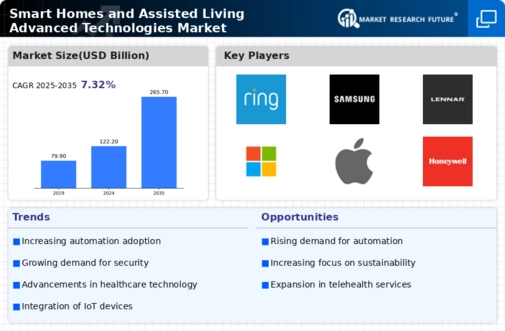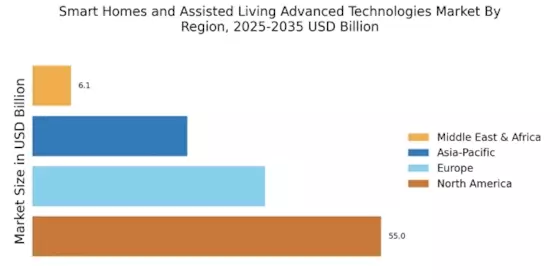Rising Demand for Home Automation
The Smart Homes and Assisted Living Advanced Technologies Market experiences a notable increase in demand for home automation solutions. This trend is driven by consumers seeking convenience, energy efficiency, and enhanced security. According to recent data, the home automation market is projected to reach a valuation of approximately 80 billion dollars by 2026. As more individuals embrace smart devices, the integration of technologies such as smart lighting, thermostats, and security systems becomes commonplace. This shift not only improves the quality of life for residents but also appeals to caregivers and family members who prioritize safety and ease of use. The growing awareness of energy conservation further propels this demand, as automated systems can optimize energy usage, leading to cost savings and environmental benefits.
Technological Advancements in IoT
The Smart Homes and Assisted Living Advanced Technologies Market is propelled by rapid advancements in Internet of Things (IoT) technologies. The proliferation of connected devices enables seamless communication between various home systems, enhancing user experience and functionality. As of 2025, it is projected that there will be over 75 billion connected devices worldwide, many of which will be integrated into smart home environments. This connectivity allows for real-time data collection and analysis, facilitating proactive health monitoring and home management. The integration of IoT in assisted living not only improves operational efficiency but also empowers users with greater control over their living environments. Consequently, the market for IoT-enabled smart home devices is expected to expand, driven by consumer demand for innovative solutions that enhance daily living.
Growing Awareness of Home Security
The Smart Homes and Assisted Living Advanced Technologies Market is increasingly shaped by the growing awareness of home security. As concerns about safety rise, consumers are actively seeking advanced security solutions that integrate seamlessly into their homes. The market for smart security systems, including surveillance cameras, smart locks, and alarm systems, is projected to reach approximately 50 billion dollars by 2026. These technologies not only deter potential intruders but also provide homeowners with real-time monitoring capabilities. The integration of artificial intelligence in security systems further enhances their effectiveness, allowing for smarter threat detection and response. This heightened focus on security is likely to drive the adoption of smart home technologies, as individuals prioritize the safety of their homes and loved ones.
Increased Focus on Health and Wellness
The Smart Homes and Assisted Living Advanced Technologies Market is witnessing an increased focus on health and wellness solutions. Consumers are becoming more health-conscious, leading to a demand for technologies that promote well-being and preventive care. Smart home devices equipped with health monitoring capabilities, such as wearable fitness trackers and smart health devices, are gaining traction. The market for health-related smart home technologies is anticipated to grow significantly, with estimates suggesting a value of over 30 billion dollars by 2027. These innovations not only assist individuals in managing chronic conditions but also provide caregivers with valuable insights into their loved ones' health. The emphasis on wellness is likely to drive further investment in smart home technologies that support healthy living and enhance the overall quality of life.
Aging Population and Increased Longevity
The Smart Homes and Assisted Living Advanced Technologies Market is significantly influenced by the aging population and increased longevity. As life expectancy rises, there is a growing need for solutions that cater to the elderly, enabling them to live independently while ensuring their safety and well-being. It is estimated that by 2030, nearly 1 in 5 individuals will be over the age of 65. This demographic shift creates a substantial market for assisted living technologies, including remote monitoring systems and emergency response solutions. These technologies not only enhance the quality of life for seniors but also provide peace of mind for families. The demand for smart home features that support aging in place is likely to continue growing, as more seniors prefer to remain in their homes rather than transition to assisted living facilities.

















Leave a Comment